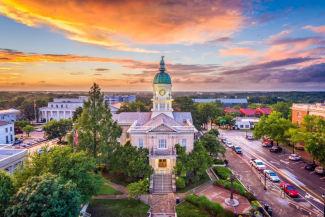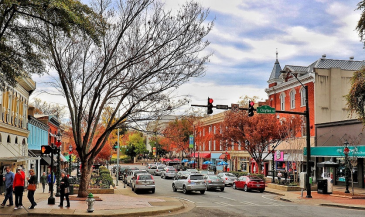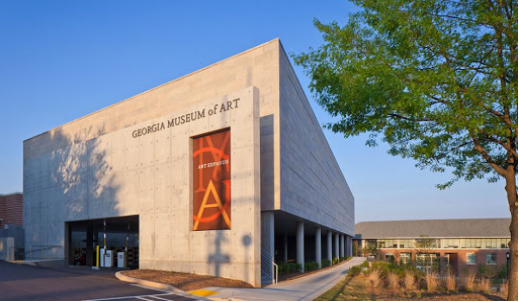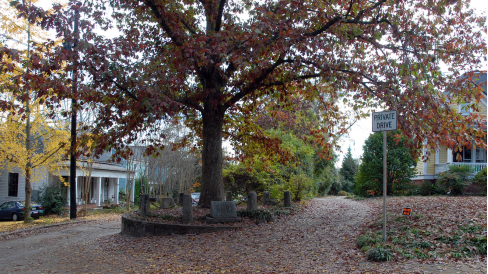Athens, Georgia 作者: 来源: 发布时间:2021-07-20
I.Population and Area
₋Area
Land: 117.8 sq mi (305.0 km2)
₋Population
Total: 115,452
Density: 851.5/sq mi (328.8/km2)

II.Natural Geography
₋Athens, officially Athens–Clarke County, is a consolidat ed city–county and college town in the U.S. state of Georgia. Athens lies about 70 miles (110 kilometers) northeast of downtown Atlanta. The University of Georgia, the state's flagship public university and an R1 research institution, is in Athens and contributed to its initial growth. In 1991, after a vote the preceding year, the original City of Athens abandoned its charter to form a unified government with Clarke County, referred to jointly as Athens–Clarke County. As of 2019, the U.S. Census Bureau's estimated population of the consolidated city-county (all of Clarke County except Winterville and a portion of Bogart) was 126,913; the entire county including Winterville and Bogart had a population of 127,064. Athens is the sixth-largest city in Georgia, and the principal city of the Athens metropolitan area, which had a 2017 estimated population of 209,271, according to the U.S. Census Bureau. Metropolitan Athens is a component of the larger Atlanta–Athens–Clarke County–Sandy Springs Combined Statistical Area, a trading area.
₋The city is dominated by a pervasive college town culture and music scene centered in downtown Athens, next to the University of Georgia's North Campus. Major music acts associated with Athens include numerous alternative rock bands such as R.E.M., the B-52's, Widespread Panic, Drive-By Truckers and Neutral Milk Hotel. The city is also known as a recording site for such groups as the A tlanta-based Indigo Girls. The 2020 book, Cool Town: How Athens, Georgia, Launched Alternative Music and Changed American Culture, describes Athens as the model of the indie culture of the 1980s.

III.GDP
₋The average salary in Athens, GA is $15.20. Trends in wages decreased by -100.0 percent in Q1 2020. The cost of living in Athens, GA is 100 percent higher than the national average. The most popular occupations in Athens, GA are Registered Nurse (RN), Certified Nurse Assistant (CNA), and Licensed Practical Nurse (LPN) which pay between $9.86 and $28.44 per year. The most popular employers in Athens, GA are Athens Regional Medical Center, University of Georgia (UGA), and Athens Orthopedic Clinic.
₋Website: https://www.payscale.com/research/US/Location=Athens-GA/Salary
IV.Industrial Characteristics
₋Businesses
₋Athens is home to a growing number of young technology companies including Docebo, Roundsphere, and Cogent Education. The city is also home to more established technology companies such as Partner Software, Peachtree Medical Billing, and Digital Insight.
₋Athens is home to several pharmaceutical manufacturing and biotechnology companies such as Merial and Janssen Pharmaceuticals, Inc. The University of Georgia also hosts its own biotechnology research centers mostly from the lower east side of town bordering Oconee county.
₋Independent publisher Hill Street Press is headquartered here. Authors with previous, or current, residence in the city include Pulitzer Prize winners Deborah Blum and Edward Larson, as well as Judith Ortiz Cofer, Reginald McKnight and Coleman Barks.
₋Tourism
₋Each spring, there are bicycle races collectively known as the Twilight Series. One of these races is the Athens Twilight Criterium.
₋Competitiveness
₋In 2010, the average household rent in Athens was $962. The national average was $1,087. Of the Athens population 25 years of age or older, 39.3% have earned a bachelor's degree or higher.
V.Attractions
1.State Botanical Garden of Georgia

₋The State Botanical Garden of Georgia is a botanical garden of 313 acres (127 hectares) in the United States, with a conservatory operated by the University of Georgia. It is located at 2450 South Milledge Avenue, Athens, Georgia.
₋The Garden contains eleven botanical and horticultural collections:
žAnnual/Perennial Garden - annuals and perennials
žDahlia Garden (1987) - dahlias
žGroundcover Collection - bugleflower, euonymus, hypericum, ivy, juniper, liriope, ophiopogon, thrift, vinca, etc.
žHeritage Garden - plants of historic and social interest to Georgia, including apples, pears, and peaches, cotton, peanuts, and tobacco.
žInternational Garden - Middle Ages (Herb Garden and Physic Garden), Age of Exploration (Mediterranean & Middle East, Spanish America, American South, and China sections), and Age of Conservation (American Indian Plants, Bog Garden, Threatened & Endangered Plants).
Native Azalea Collection - azaleas
Native Flora Garden - more than 300 species, including ferns, trilliums, bloodroot, and lady slipper orchids.
Rhododendron Collection (1976) - rhododendrons
Flower Garden - Brand new in 2008.
Shade Garden - azalea, camellia, dogwood, laurel, magnolia, redbud, and viburnum.
Trial Garden - shrubs and trees under evaluation for the southeastern United States.
₋It also contains about 5 miles (8.0 km) of nature trails.
₋In 1984, it received the designation as Georgia's "State Botanical Garden".
₋Address: 2450 S Milledge Ave, Athens, GA 30605, United States
₋Phone: +1 706-542-1244
₋Website: https://botgarden.uga.edu/visit-us/gardens-and-collections/
2. Georgia Museum of Art

₋The Georgia Museum of Art is an art museum in Athens, Georgia, United States, associated with the University of Georgia. The museum is both an academic museum and, since 1982, the official art museum of the state of Georgia.1982 The permanent collection consists of American paintings, primarily 19th- and 20th-century; American, European and Asian works on paper; the Samuel H. Kress Study Collection of Italian Renaissance paintings; growing collections of southern decorative arts and Asian art; and a strong collection of works by African American artists. It numbers more than 12,000 works, growing every year.
₋The Georgia Museum opened on UGA's North Campus in 1948, in a building that now houses the university president's office, then moved to the Performing and Visual Arts Complex on UGA's East Campus in 1996. In 2011, it completed an extensive expansion and remodeling of its building, paid for entirely with externally raised funds and designed by Gluckman Mayner Architects, New York, that has allowed it to display its permanent collection continually. The museum offers programming for patrons of all ages, from child to senior citizen, as well as free admission to the public for all exhibitions. It organizes its own exhibitions in-house, creates traveling exhibitions for other museums and galleries and plays host to traveling exhibitions from around the country and the globe. The museum strives, most of all, to fulfill the legacy of its founder, Alfred Heber Holbrook, and provide art for everyone, removing barriers to accessibility and seeking to foster an open, educational and inspiring environment for students, scholars and the general public.
₋The foundation of the museum's collection, the Eva Underhill Holbrook Memorial Collection of American Art, a collection of 100 American paintings, was donated to UGA in 1945 by Holbrook in memory of his first wife. Included in this collection are works by such luminaries as Frank Weston Benson, William Merritt Chase, Stuart Davis, Arthur Dove, Georgia O’Keeffe, Childe Hassam, Winslow Homer, Jacob Lawrence and Theodore Robinson.
₋Located in: University of Georgia
₋Address: 90 Carlton St, Athens, GA 30602, United States
₋Phone: +1 706-542-4662
₋Website: https://georgiamuseum.org/
3. Tree That Owns Itself

₋The Tree That Owns Itself is a white oak tree that, according to legend, has legal ownership of itself and of all land within eight feet (2.4 m) of its base. The tree, also called the Jackson Oak, is at the corner of South Finley and Dearing Streets in Athens, Georgia, United States. The original tree, thought to have started life between the mid-16th and late 18th century, fell in 1942, but a new tree was grown from one of its acorns, and planted in the same location. The current tree is sometimes referred to as the Son of the Tree That Owns Itself. Both trees have appeared in numerous national publications, and the site is a local landmark.
₋The earliest-known telling of the tree's story comes from a front-page article entitled "Deeded to Itself" in the Athens Weekly Banner on August 12, 1890. The article explains that the tree had been located on the property of Colonel William Henry Jackson. William Jackson was the son of James Jackson (a soldier in the American Revolution as well as a congressman, U.S. senator, and governor of Georgia), and the father of another James Jackson (a congressman and Chief Justice of the Supreme Court of Georgia). He was the brother of Jabez Young Jackson, also a congressman. (William Jackson was reportedly a professor at the University of Georgia, and is sometimes given the title of Doctor. The nature of his military service and the source of the title "Colonel" are unknown.) Jackson supposedly cherished childhood memories of the tree, and, desiring to protect it, deeded to it the ownership of itself and its surrounding land. By various accounts, this transaction took place between 1820 and 1832.
₋Address: 277 S Finley St, Athens, GA 30605, United States
₋Website: https://www.atlasobscura.com/places/tree-owns-itself
VI.History
₋In the late 18th century, a trading settlement on the banks of the Oconee River called Cedar Shoals stood where Athens is today. On January 27, 1785, the Georgia General Assembly granted a charter by Abraham Baldwin for the University of Georgia as the first state-supported university. Sixteen years later, in 1801, a committee from the university's board of trustees selected a site for the university on a hill above Cedar Shoals, in what was then Jackson County. On July 25, John Milledge, one of the trustees and later governor of Georgia, bought 633 acres (256 hectares) from Daniel Easley and donated it to the university. Milledge named the surrounding area Athens after the city that was home to the Platonic Academy of Plato and Aristotle in Greece.
₋The first buildings on the University of Georgia campus were made from logs. The town grew as lots adjacent to the college were sold to raise money for the additional construction of the school. By the time the first class graduated from the university in 1804, Athens consisted of three homes, three stores, and a few other buildings facing Front Street, now known as Broad Street. Completed in 1806 and named in honor of Benjamin Franklin, Franklin College was the first permanent structure of the University of Georgia and of the city of Athens. This brick building is now known as Old College.
₋Athens officially became a town in December 1806 with a government made up of a three-member commission. The university and town continued to grow with cotton mills fueling the industrial and commercial development. Athens became known as the "Manchester of the South" after the city in England known for its mills. In 1833 a group of Athens businessmen led by James Camak, tired of their wagons getting stuck in the mud, built one of Georgia's first railroads, the Georgia, connecting Athens to Augusta by 1841, and to Marthasville (now Atlanta) by 1845. In the 1830s and 1840s, transportation developments and the growing influence of the University of Georgia made Athens one of the state's most important cities as the Antebellum Period neared the height of its development. The university essentially created a chain reaction of growth in the community which developed on its doorstep.
₋During the American Civil War, Athens became a significant supply center when the New Orleans armory was relocated to what is now called the Chicopee building. Fortifications can still be found along parts of the North Oconee River between College Avenue and Oconee Street. In addition, Athens played a small part in the ill-fated Stoneman's Raid when a skirmish was fought on a site overlooking the Middle Oconee River near what is now the old Macon Highway. A Confederate memorial stands on Broad Street near the University of Georgia Arch.
₋During Reconstruction, Athens continued to grow. The form of government changed to a mayor-council government with a new city charter on August 24, 1872, and Henry Beusse was elected as the first mayor of Athens. Beusse was instrumental in the city's rapid growth after the Civil War. After serving as mayor, he worked in the railroad industry and helped bring railroads to the region, creating growth in many of the surrounding communities. Freed slaves moved to the city, where many were attracted by the new centers for education such as the Freedmen's Bureau. This new population was served by three black newspapers: the Athens Blade, the Athens Clipper, and the Progressive Era.
₋In the 1880s, as Athens became more densely populated, city services and improvements were undertaken. The Athens Police Department was founded in 1881 and public schools opened in fall of 1886. Telephone service was introduced in 1882 by the Bell Telephone Company. Transportation improvements were also introduced with a street paving program beginning in 1885 and streetcars, pulled by mules, in 1888.
₋By its centennial in 1901, Athens had experienced a century of development and growth. A new city hall was completed in 1904. An African-American middle class and professional class grew around the corner of Washington and Hull Streets, known as the "Hot Corner", where the Morton Building was constructed in 1910. The theater at the Morton Building hosted movies and performances by black musicians such as Louis Armstrong, Cab Calloway, and Duke Ellington. In 1907 aviation pioneer Ben T. Epps became Georgia's first pilot on a hill outside town that would become the Athens-Ben Epps Airport.
₋During World War II, the U.S. Navy built new buildings and paved runways to serve as a training facility for naval pilots. In 1954, the U.S. Navy chose Athens as the site for the Navy Supply Corps school. The school was in Normaltown in the buildings of the old Normal School. It closed in 2011 under the Base Realignment and Closure process. The 56-acre (23-hectare) site is now home to the University of Georgia/Medical College of Georgia Medical Partnership, the University of Georgia College of Public Health, and other health-related programs
₋In 1961, Athens witnessed part of the civil rights movement when Charlayne Hunter and Hamilton Holmes became the first two black students to enter the University of Georgia. Despite the Brown vs. Board of Education Supreme Court ruling in 1954, the Athens–Clarke County school district remained segregated until 1964.
VII.Other Information
₋Transportation
₋Highways
₋The city is the focus of U.S. Highways U.S. Route 29 (US 29), US 78, US 129, US 441, and Georgia State Route 72 (SR 72), and near the eastern terminus of SR 316 and the southern terminus of SR 106. Other state routes in Athens are SR 8 and SR 15, which follow US 29 and US 441 respectively, SR 10 which follows US 78 east and west of Athens but deviates to US 78 Bus. to go through Athens, and SR 15 Alt. which starts at the SR 10 Loop interchange at Milledge Avenue and follows Milledge and Prince Avenues to US 129 which it follows to the north. The SR 10 Loop serves as a limited-access perimeter. The city is bisected east to west by Broad Street/Atlanta Highway (US 78 Bus. and SR 10) and north to south by Milledge Avenue (SR 15 Alt.). Lumpkin Street, Prince Avenue (SR 15 Alt.), North Avenue, and Oconee Street (US 78 Bus.) along with Broad Street are major thoroughfares radiating from downtown. College Station Road and Gaines School Road are major thoroughfares on the east side of Athens, along with US 78 east (Lexington Road). On the west side, most major thoroughfares intersect US 78 Bus. (Broad Street/Atlanta Highway), including Alps Road/Hawthorne Avenue, Epps Bridge Parkway, and Timothy Road/Mitchell Bridge Road.
₋Airports
₋Athens-Ben Epps Airport (FAA code AHN) has been operational since 1917. It is east of downtown outside Georgia State Route 10 Loop and north of US Route 78. AHN qualifies for air service to be provided under the Essential Air Service provisions. SeaPort Airlines provides commercial air service to Nashville International Airport, TN. Until 2012, Georgia Skies and Wings Air provided commercial air service to Atlanta, and until 2008 (prior to either airline's current AHN service), US Airways provided service to Charlotte. Hartsfield-Jackson International Airport (ATL) is the primary point of departure and arrival for Athenians due to the relative lack of air service to AHN.
₋Alternative
₋Athens encourages use of alternative transportation. Bike lanes are provided on major thoroughfares. A rail-to-trail redevelopment is being considered to connect Downtown with the East Side. Organizations such as BikeAthens support and encourage biking. Skateboarding and small scooters are also common sights around UGA campus and Downtown.
₋Bus
₋Athens Transit provides intracity transit seven days per week. UGA Campus Transit provides fare-free 24 hours/5 days a week transit around the University of Georgia campus, Milledge Avenue and Prince Avenue on the way to UGA's newest campus, the Health Sciences Campus. Southeastern Stages, a subsidiary of Greyhound Lines, provides intercity bus services. Low cost curbside bus service to Atlanta and Charlotte is also provided by Megabus.
₋Rail
₋Athens has no direct passenger rail service; the closest Amtrak stations are in Atlanta, Gainesville, and Toccoa. Until the 1950s and 1960s the Seaboard Air Line Railroad's daily Cotton Blossom (ended, 1955), Washington - Atlanta, Silver Comet, New York - Birmingham and Tidewater (ended, 1968), Norfolk - Birmingham service made stops at the SAL's Athens depot at College Avenue and Ware Street, north of downtown. Train service to Athens ended with the last run of the Silver Comet in 1969. Until the early 1950s, the Southern Railway ran a passenger to Lula on the Southern's main line northeast of Gainesville. Into the same period, the Central Railroad of Georgia ran mixed passenger and freight trains south to Macon's Terminal Station.
₋Freight service is provided by CSXand Athens Line, the latter having leased tracks from Norfolk Southern. The Georgia Department of Transportation has proposed the city as the terminus of a commuter line that links Atlanta and Gwinnett County along the Georgia 316 corridor.
₋Utilities
₋Electric service in Athens-Clarke is provided by three customer-owned electric cooperatives, Walton EMC, Rayle EMC and Jackson EMC, as well as by Georgia Power, a subsidiary of Southern Company. Water utility is provided by the city. Garbage is provided by private companies according to customer purchase, though the city does offer municipal garbage pick up as a service. Natural gas is supplied by Atlanta Gas Light through various marketers within the deregulated market.
VIII.Contact Information
₋Government
Mayor: Kelly Girtz
₋City Hall
₋Address: 301 College Ave, Athens, GA 30601, United States
₋Phone: +1 706-613-3795
₋Website: https://athensclarkecounty.com/84/City-Hall
